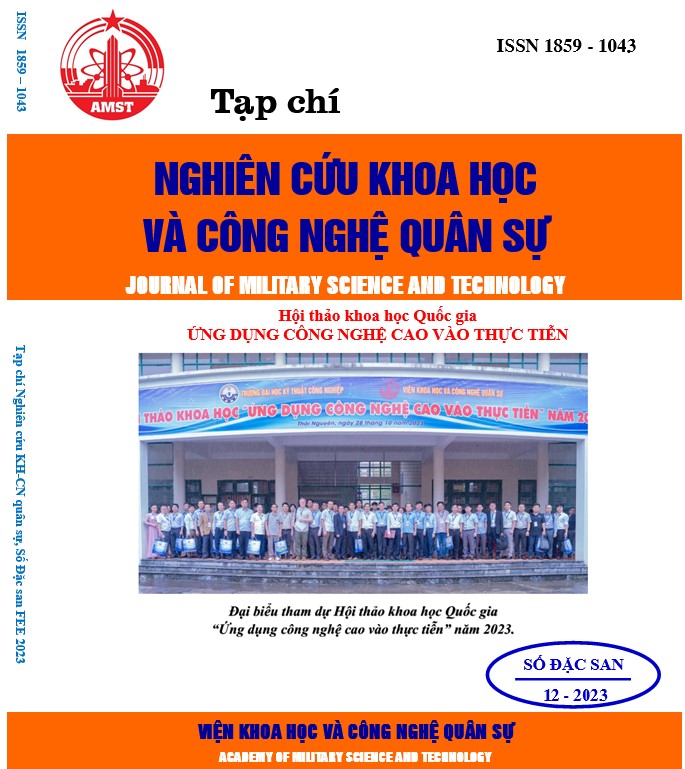Effects of Tinuvin 292 on ageing-resistance properties of electromagnetic transparent coating
465 viewsDOI:
https://doi.org/10.54939/1859-1043.j.mst.FEE.2023.223-229Keywords:
UV protection agent; Transparent electromagnetic; Tinuvin 292; Ageing resistance; Weather resistance.Abstract
The coating for the radar must satisfy the requirements of resistance to severe weather conditions while allowing electromagnetic waves to transfer almost completely. UV protection agents are added during the coating manufacturing process to limit the effects of ultraviolet rays in sunlight, improve colour fastness, and ensure the mechanical properties of the coating. In this paper, the author presents the results of a study to evaluate the effectiveness of the amine-based UV protection agent Tinuvin 292 under test conditions of colour difference ΔE (ASTM 2244), gloss loss (TCVN 2101: 2016) on samples of electromagnetic transparent coating (ETC) based on ester epoxy alkyd resin (EEA). Electromagnetic transparent coating with 2% Tinuvin 292 additive improves ageing resistance and weather resistance, ΔE = 2.15, gloss loss reached 12.1% at an angle of 60° while ensuring durability requirements mechanics, electrical properties, and electromagnetic transparency of coating film.
References
[1]. Đ. T. Thiêm et al., "Nghiên cứu tổng hợp nhựa alkyd GP-019 và biến tính nhựa epoxy E-40 để chế tạo este epoxy alkyd E-30," Tạp chí Nghiên cứu Khoa học và Công nghệ quân sự, pp. 155-161, (2020).
[2]. Puts, Gerard J, Philip Crouse, and Bruno M Ameduri, "Polytetrafluoroethylene: synthesis and characterization of the original extreme polymer," Chemical reviews, Vol. 119, No. 3, pp. 1763-1805, (2019). DOI: https://doi.org/10.1021/acs.chemrev.8b00458
[3]. N. T. Vuong et al., "Stability of acrylic polyurethane coatings under accelerated aging tests and natural outdoor exposure: The critical role of the used photo-stabilizers," Progress in Organic Coatings, Vol. 124, pp. 137-146, (2018). DOI: https://doi.org/10.1016/j.porgcoat.2018.08.013
[4]. Amrollahi, S. Mohseni, M. Ramezanzadeh, "Fabrication of a low surface energy acrylic/melamine clearcoat with enhanced weathering and biological resistances: Investigation of the role of organic UV absorber and nanosilica particles," Progress in Organic Coatings, Vol. 105, pp. 132-142, (2017). DOI: https://doi.org/10.1016/j.porgcoat.2017.01.003
[5]. Singh, R. P., Namrata S. Tomer, and S. Veera Bhadraiah, "Photo-oxidation studies on polyurethane coating: effect of additives on yellowing of polyurethane," Polymer Degradation and Stability, Vol. 73, No. 3, pp. 443-446, (2001). DOI: https://doi.org/10.1016/S0141-3910(01)00127-6
[6]. Yousif, Emad Hasan, Ali, "Photostabilization of poly (vinyl chloride)–Still on the run," Journal of Taibah University for Science, Vol. 9, No. 4, pp. 421-448, (2015). DOI: https://doi.org/10.1016/j.jtusci.2014.09.007
[7]. Thạo, Phạm Xuân, et al., "Nghiên cứu biến tính nanosilica bằng polydimethylsiloxane dùng để tăng cường độ bền cơ lý và độ bền môi trường của sơn trong suốt điện từ," Journal of Military Science Technology, Vol. 88, pp. 66-72, (2023). DOI: https://doi.org/10.54939/1859-1043.j.mst.88.2023.66-72
[8]. Di Crescenzo, Marta Melchiorre, et al., "The use of waterborne paints in contemporary murals: Comparing the stability of vinyl, acrylic and styrene-acrylic formulations to outdoor weathering conditions," Vol. 107, pp. 285-293, (2014). DOI: https://doi.org/10.1016/j.polymdegradstab.2013.12.034
[9]. Saadat-Monfared, A Mohseni, M Tabatabaei, M Hashemi, "Polyurethane nanocomposite films containing nano-cerium oxide as UV absorber. Part 1. Static and dynamic light scattering, small angle neutron scattering and optical studies," Colloids Surfaces A: Physicochemical.
[10]. Engineering Aspects, Vol. 408, pp. 64-70, (2012). DOI: https://doi.org/10.1016/j.colsurfa.2012.05.027
[11]. Dupuis, Aurélie, et al., "Photo-oxidative degradation behavior of linseed oil based epoxy resin," Polymer Degradation and Stability, Vol. 135, pp. 73-84, (2017). DOI: https://doi.org/10.1016/j.polymdegradstab.2016.11.021
[12]. Roger, Daniel, "Photogegradation and Photostabilization of Wood and Wood coatings,", Ciba Specialty Chemicals, (2004).
[13]. Diệu, Trần Vĩnh, Phạm Anh Tuấn, and Bạch Trọng Phúc, "Nghiên cứu ảnh hưởng của phụ gia chống bức xạ tử ngoại đến tính chất cơ học và khả năng chậm lão hóa của vật liệu polyme compozit trên cơ sở dầu lanh epoxy hóa," Vietnam Journal of Chemistry, Vol. 53, No. 4, pp. 531-534, (2015).
[14]. T. V. Nguyen et al., "Effect of rutile titania dioxide nanoparticles on the mechanical property, thermal stability, weathering resistance and antibacterial property of styrene acrylic polyurethane coating," Advances in Natural Sciences: Nanoscience and Nanotechnology, Vol. 7, pp. 045015-045024, (2016). DOI: https://doi.org/10.1088/2043-6262/7/4/045015
[15]. Ahmad, Zulkifli, "Polymer dielectric materials, Dielectric material, IntechOpen, (2012). DOI: https://doi.org/10.5772/50638







